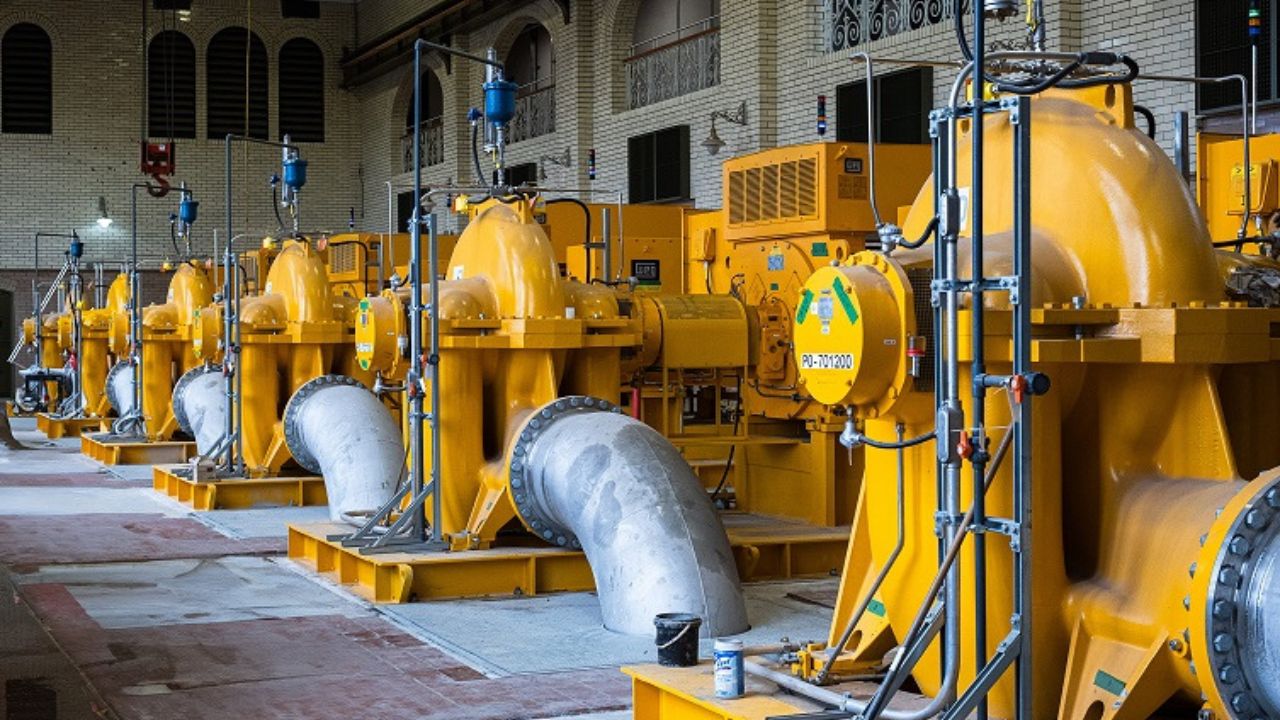The water feeding these two plants is extracted from the St Lawrence River and is purified by a combination of filtration, ozonisation, ultraviolet (UV) water treatment and finally chlorination at the Charles-J-Des Baillets. From there it is diverted to the Atwater plant for distribution through the City’s network of pipes.
Should it be necessary to shut down either the Charles-J- Des Baillets plant or the Atwater plant, water can be diverted to and from either plant. This ensures that water levels in all seven reservoirs around the metropolitan area of Montréal are maintained at optimum capacity. Both production plants are interconnected via sizeable piping, so that in the unlikely event of one plant going down, water can still be supplied to the reservoirs.
History
The Atwater drinking water treatment plant site represents an important part of Montréal’s heritage, this being attributable to its historical, scientific/technical, architectural and artistic, as well as landscape values. Originally constructed in 1868 the Atwater plant has undergone many changes since then, the first being the construction of the central pumping station in 1923 and the replacement of the original steam pumps with electric pumps. Over the past 100 years, the plant has played a critical role in the development of the city, through its contribution to public safety and health. Considerable investments have been made by the City of Montréal in order to increase production capacity and improve overall operating efficiency. The most recent investment has been to refurbish and expand the pumping facilities through the replacement of aging pumps with purpose-designed units manufactured by KSB which have brought output up to 700,000 m³ per day of drinking water for a large area of Montréal Island.
Project
As part of the project involving the refurbishment of equipment at potable water production plants, pumping stations and reservoirs (REQUP 1), the City of Montréal launched a public tender for the pre-purchase of six (6) new motor-pump sets (MPS) and their components in 2018. This would include medium voltage synchronous electrical motors with exciters, switch gear cabinets, all to replace the aging high-pressure pumps in the Atwater potable water pumping station.
The very nature of the project, it being a complete replacement of the pumps in an existing pumping hall, threw up a range of challenges for KSB’s engineers to address, not least of these being the design of the pump specified by the client. In the terms of the contract, the pump manufacturer would be responsible for the supply of the pumps and all related electrical components, as well as assisting in the installation of the units, their commissioning, testing and post-commission personnel training. Key to the project was that the pumps had to be centrifugal single-stage horizontal split-case, double-suction, double-volute pumps with bottom entry suction and discharge on the horizontal side. The requirement for bottom suction entry and side discharge was dictated by the existing piping infrastructure within the pump house. Being an existing pump station, it was critical to ensure that the dimensions of the equipment to be supplied complied with all the dimensions and clearances so that the equipment could be installed in the available space while taking into account the existing structures, including the location of the water intake and discharge pipes. Any modification to this old configuration would have had a huge impact (in engineering and cost) on the piping arrangement and construction at site.
KSB takes on the challenge
KSB’s working relationship with the City of Montréal goes back over 40 years, when in the late 1970’s it supplied five of its type ME 5,500HP 4200 l/s pumps to the Charles-J.-Des Baillets water treatment plant. In 2015 a further KSB ME pump was installed, this coming on stream in 2018, which enabled the plant to operate to its optimum design capability. It was in the spring of 2018 that KSB was invited to tender for the supply pumps for the Atwater plant, eventually being awarded the contract at the end of that year. The contract award would take into account not only the acquisition cost, but also the operating cost of electrical energy over 25 years. This meant that the pump sets had to deliver high levels of operating efficiency.
In order to meet the contract criteria KSB’s engineers in Halle, Germany, had to manufacture a bottom entry suction pump, a design which is not a common standard design, and meet 29 essential hydraulic and mechanical criteria. As a result the pump was custom-made to this design and subjected to full factory testing with the specific project motor and the specific project switch gear at the factory in Germany.
Equipment Supplied
The pumps designed and supplied were six single-stage horizontal split case double suction pumps, each fitted with 948mm double-entry radial impellers. Each pump comes with a 2500HP synchronous motor with brushless exciter. The pumps are rated to operate at 1580l/s at a head of 73m. Included in the package are an excitation control panel and electrical integration services.
A further issue was the need to keep the plant operational at all times during the refurbishment work. This was achieved by extending the installation of the equipment over an extended period, whereby the existing pumps would be taken out sequentially and replaced by the new pumps. In order for this to be fulfilled, all the units were fabricated by KSB at the same time then stored at a nearby site for the duration of the refurbishment program, this being two years.
Concerns were raised with regard to any possible delay in the delivery of the new equipment. This was because the obsolescence of existing pumps would worsen as spare parts were no longer available. In addition, the plant would have to deal with two separate electrical power systems, which is not recommended. In fact, the new pumps were to be connected to the 25 KV power system while the existing pumps would continue to be powered by the existing 12 KV power system, which was reaching the end of its useful life. This situation was identified as creating additional costs in the maintenance and management of the operation.
All six pumps were fabricated and ready for factory testing in early 2020, right at the beginning of the COVID pandemic. The Halle factory maintained the testing schedule despite personnel shortages. Due to global sanitary restrictions, the client was not able to witness the tests at the factory in Germany in person. This difficulty was resolved by allowing remote participation via video conference to the factory test bench. All tests were successful and even improved the theoretical efficiency.
Summary
KSB shipped all equipment from Germany to a storage site in Montréal area where periodic (monthly) maintenance was performed on the units during storage. The first two pumps were installed and commissioned in 2022, with the four remaining units being installed and commissioned in August 2023.
The contractor installed all the pumps and electrical equipment and completed the inter connection wirings between the switchgear, motor control and excitation panels. KSB inspected the pumps and motor mechanical installation. Also KSB’s subcontractor (electrical integrator) checked all the wirings from/to all the above mentioned equipment, these being sensors, motors, switchgear, motor control and excitation control panels. KSB was also present during the pump SAT.
All pumps were retested onsite and achieved all required performance, followed by personnel training for pumps, motors and switchgears undertaken in September/October 2023.
Source: KSB SE & Co. KGaA



